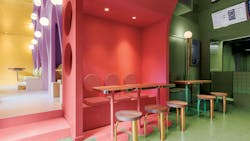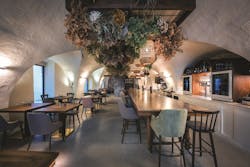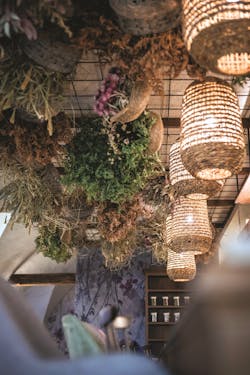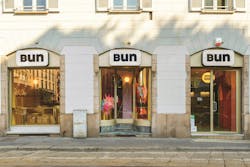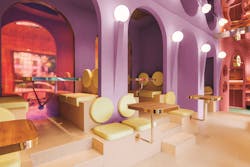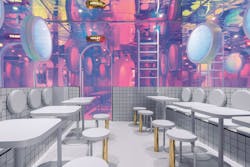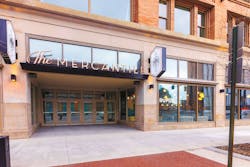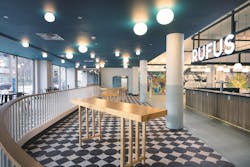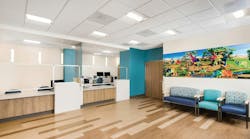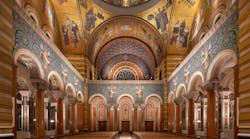The exploding fast-casual segment of the dining market exists as an upgrade from the time-focused, fast-food experience while stopping short of fabric napkins and fine dining. One quality helping to carve out success in these spaces — unique and appealing interiors, where lighting plays a pivotal role.
“It is really critical that fast-casual restaurants offer a décor that brings in traffic throughout the day,” says Ana Milena Herandez of Masquespacio, designer of Bun Burgers, which she says has a more youthful clientele. The ultimate goal, she says, is to create a brand identity with younger generations, specifically millennials. “We’re in an extremely design-conscious era. Restaurants need to create bold, eye-catching backdrops for customer’s own enjoyment and to mount on social media feeds.”
In a fast-casual restaurant, the ambiance must accomplish more than just looking good. These restaurants differentiate themselves by creating a real sense of place. This means making the most of the nuances that the footprint of the space may have and drawing attention to the various nooks and coves designed as spots to enjoy a meal. In terms of the visual environment, with the proliferation of social media and photo-centric sites, like Instagram, the interior has to help the food visually translate online because people are taking pictures of their main courses and posting them onto their feeds before they eat.
Here is a closer look at how some fast-casual spaces are using lighting and illumination to craft a brand identity that meets the needs of a fast, casual diner.
Enjoy informality at Bistro Bogen
Interior designer Silvia Marzani of noa* (network of architecture) describes the design of Bistro Bogen as “a dialogue between past and present, a strong contemporary character within a centuries-old structure. It combines the past and present at the same time.” Located in Bolzano, Italy, the region’s architectural history can be traced to the medieval era.
Formerly a barrel-vaulted workshop, the 62-ft.- long interior continues the theme established by the arches over the cobblestone streets and the entry to the restaurant carved out of the white façade. Marzani and Stefan Rier, noa* founder and lead architect for Bistro Bogen (“bogen” is German for “arch”), imparted an informal mood to the dining area. Suspended over the long central table is an assemblage of upturned baskets of dried flowers, which Marzani says symbolize “transience but at the same time the beauty of life.” Interspersed are fixtures by Light & Living of woven open-work natural rattan shades illuminated by a single LED lamp, 40W, 2700K.
Along the side of the space are wood-topped dining tables and coordinating wood and molded-frame chairs. On the structural vault supports are a pair of Rotliana wall fixtures, each with a 29W, 2700K LED lamp. Above designated tables is a single slender black shade pendant by Lodes containing a 6.2W, 2700K lamp. Accenting the upward curve of the arches are floor lamps by Muuto, 54-in. tall, with two LED lights at 6W and 2700 K.
Bun Burger shows its colors
In Milan, an Italian hamburger chain, Bun Burger, had to appeal to a clientele that included patrons from the upscale Brera art and retail district as well as college students from the adjacent university. Spanish interior design studio Masquespacio gave the space a visual identity that is both mature and sophisticated and fun and vibrant. Design elements distinct to Bun’s identity are incorporated into this space, including arches, elevated benches, and signature furniture pieces like round stools, tables, seating pads, and light fixtures. Another key component of the Bun Burger brand: color.
Masquespacio’s sixth collaboration for this 1,100-sq.-ft. Bun lifts the traditional fast-food burger joint to a colorful, inviting fast-casual destination that opened in September 2021. For the Brera facility, pink, purple, green and yellow fill the restaurant’s interior in color-blocked patterns. Gold accents were selected to provide the hint of luxury that diners in this area may expect or appreciate. Other hues in the palette create both contrast and continuity in the space.
Christophe Panasse, a co-founder of Masquespacio, led the design team to create the interior architecture and the lighting plan for the space’s arch-framed alcoves and other space dividers that offer diners a diversion from typical open seating in fast-food establishments. “By offering customers several different seating options—in the alcoves or at tables in different-colored sections—they can dine at the restaurant again and again and have a new experience every time,” explained Panasse.
Lighting is used to draw people’s attention to all of the options they have to choose a seat. Glowing white globes are mounted on individual tapered sculptural platforms extending from the spaces between the arches. In other areas, they are supported by a polished metal standard to provide visual continuity throughout the restaurant’s levels.
A small area of the restaurant was designed to resemble a swimming pool. The half-tiled walls have a distinct natatorium style, and the reflective iridescent blue and pink panels on the walls and ceiling create reflections with a wave-like quality. Even the lighting fixtures on the walls resemble the circular windows often found underwater.
The architect for the project was Luca Gobbo of Milan, Italy, and Augusto Contract served as the general contractor, collaborating with Masquespacio for the furniture and custom lighting.
A fast-casual food court
Once the home of the 1.1 million-sq.-ft. Sibley’s, Lindsay and Curr department store in Rochester, N.Y., a massive renovation has turned the c. 1907 building into offices, apartments, labs, retail, and a first-floor food court, the Mercantile. The decade-long adaptive reuse project led by Winn Development became known as Sibley Square and is a prominent anchor for Rochester’s ongoing downtown revitalization.
Touted as Rochester’s new urban eatery, the restaurants inside the Mercantile on Main are described as providing a “curated collection of some of the best food and drink this town has to offer.” Vendors offer options for breakfast, lunch, dinner, happy hour, and late-night eats, so whatever it may be called, it certainly is not a typical food court.
Architects for the project, The Architectural Team (TAT), based in Chelsea, Mass., took full advantage of The Mercantile’s open plan and 16.6-ft. tall ceiling height to give the vendors their own identifiable areas, rather than simply a counter in front of the food preparation activities as is the multi-vendor format found in most interior food courts. Two local restaurants, Rufus and RoCoCo Coffee Co., adopted a fast-casual approach to their dining operations. Meghann Van Dorn, TAT’s director of interior design, observes that casual dining has evolved dramatically in the past several years. “We’re seeing interest in visually rich environments designed to maintain activity throughout the day. In a marketplace like the Mercantile, this translates into a balance of vendor stalls, social spaces, seating options, and services in a layered palette that combines color, textures, and contemporary materials,” Van Dorn points out.
To define the Rufus space, Van Dorn chose a black and white harlequin floor pattern topped by a curved white slat fence. Above is a dropped, deep blue painted ceiling punctuated by flush-mounted circular white fixtures by Flos. The larger measures 12-in. diameter × 10.5-in. high; the smaller is 7.5-in. diameter × 6.3-in. high.
For RoCoCo, the enclosed dining area is outlined overhead by a suspended black frame. Inside is a group of ceiling-hung pendants of opal glass and aged brass by Mitzi Lighting. Around the perimeter of the space are XAL’s 3000K LED black track fixtures.
When fast-casual dining first took hold, experts debated its longevity, but diners have decided fast-casual is here to stay.
This article appeared in the September 2022 issue of Architectural SSL magazine.
